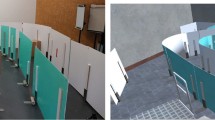Abstract
This paper describes the development of a driver model in a powered wheelchair operation. Existing methods have known problems such as straining the user. This is because improving wheelchairs adjustment requires too many trails and errors. Thus, we proposed solutions using computer simulation in this study. Computer simulation for the improvement of wheelchair adjustment needs three models: surroundings, driver and vehicle. Surroundings and vehicle models based on existing researches can be made, but not driver models for the computer simulation. To construct the model, we extracted the operation characteristics using a powered wheelchair simulator. From these results, we constructed the driver model as the first order preview driver model. In addition, a computer simulation was proposed for adjusting a powered wheelchair.
Chapter PDF
Similar content being viewed by others
References
Plochl, M., et al.: Driver models in automobile dynamics application. Vehicle System Dynamics 45(7-8), 699–741
Yamakawa, Y., et al.: Development of Electric Wheelchair with Operational Force Detecting Device for Persons with Severe Disability (in Japanese). In: Proceedings of the Welfare Engineering Symposium, vol. 2006, pp. 39–42 (2006)
Author information
Authors and Affiliations
Editor information
Editors and Affiliations
Rights and permissions
Copyright information
© 2009 Springer-Verlag Berlin Heidelberg
About this paper
Cite this paper
Ito, T., Inoue, T., Shino, M., Kamata, M. (2009). Development of a Driver Model in Powered Wheelchair Operation. In: Duffy, V.G. (eds) Digital Human Modeling. ICDHM 2009. Lecture Notes in Computer Science, vol 5620. Springer, Berlin, Heidelberg. https://doi.org/10.1007/978-3-642-02809-0_41
Download citation
DOI: https://doi.org/10.1007/978-3-642-02809-0_41
Publisher Name: Springer, Berlin, Heidelberg
Print ISBN: 978-3-642-02808-3
Online ISBN: 978-3-642-02809-0
eBook Packages: Computer ScienceComputer Science (R0)




